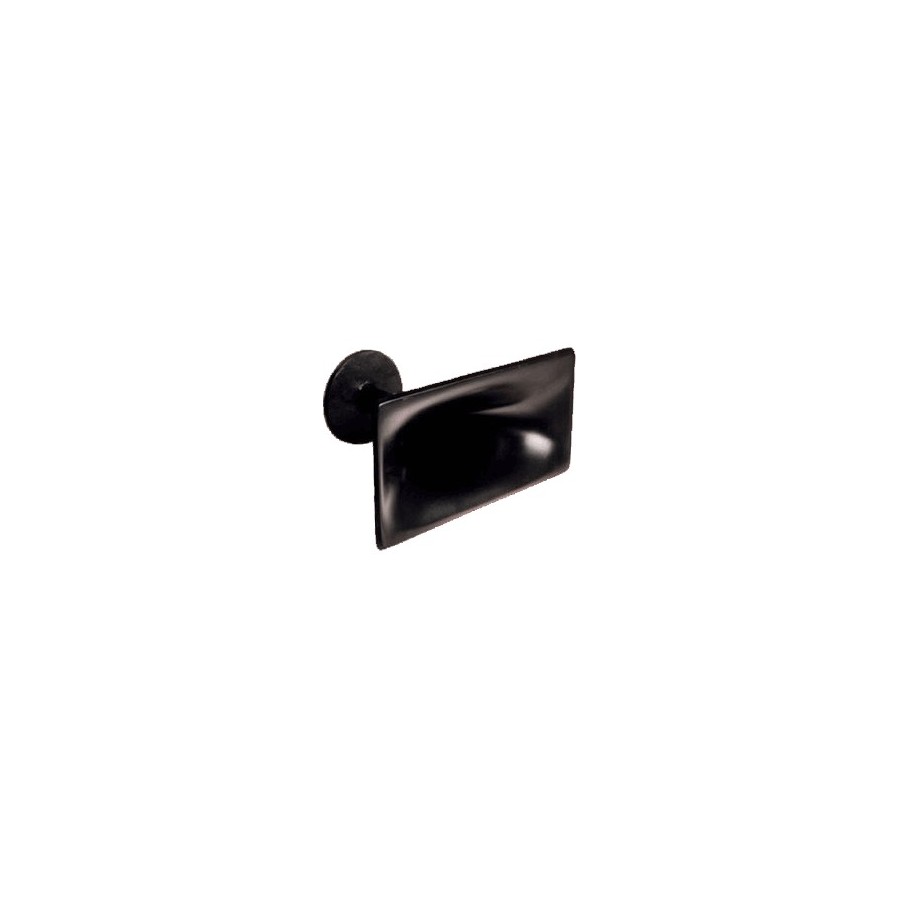I understand! Modern Prosound/proaudio compression drivers are seen in some ways 'ultimate' for sound reproduction, so was just wondering if there if there is a matching modern prosound/proaudio horn design as well
Speaking of Strauss... This is a topclass prosound horn:

Some Brief Notes
An os horn is not the geometry of a complete finite acoustic horn that follows this geometry only in the throat and body. As the mouth is approached the profile radius needs to return to a decline in respect to horn axial length; and while doing so, avoids discontinuities in the bounding curve's 2nd. derivative; i.e., at the point of departure for mouth lips, the radii of curvature should match. If this tack is followed, reflectance will be minimized within the horns pass-band, the lower boundary of which, is roughly defined by the relation wavelength/(mouth circumference) = 1.
References to horns designed using shape optimization techniques may be found at the reference provided and elsewhere. These are relatively recent studies compared to those mentioned here so far.
Google Scholar
The acoustic load presented to a compression driver by a horn only becomes important if there is a concerted effort to extend the response/output of its lower frequency bound necessitated by some venue force majeure.
The dual direct radiator issues can be mitigated by a crossover that progressively engages the second driver to meet increasing VD requirements concomitant with lower frequency reproduction. Here, because wave length is so much larger the driver dimensions, the two drivers behave as a single source. Above this domain only the top driver is engaged in the overlap region shared by the tweeter.
WHG
An os horn is not the geometry of a complete finite acoustic horn that follows this geometry only in the throat and body. As the mouth is approached the profile radius needs to return to a decline in respect to horn axial length; and while doing so, avoids discontinuities in the bounding curve's 2nd. derivative; i.e., at the point of departure for mouth lips, the radii of curvature should match. If this tack is followed, reflectance will be minimized within the horns pass-band, the lower boundary of which, is roughly defined by the relation wavelength/(mouth circumference) = 1.
References to horns designed using shape optimization techniques may be found at the reference provided and elsewhere. These are relatively recent studies compared to those mentioned here so far.
Google Scholar
The acoustic load presented to a compression driver by a horn only becomes important if there is a concerted effort to extend the response/output of its lower frequency bound necessitated by some venue force majeure.
The dual direct radiator issues can be mitigated by a crossover that progressively engages the second driver to meet increasing VD requirements concomitant with lower frequency reproduction. Here, because wave length is so much larger the driver dimensions, the two drivers behave as a single source. Above this domain only the top driver is engaged in the overlap region shared by the tweeter.
WHG
Last edited:
A diy project built around one of Marcel's (mabat) STH (now ATH4) waveguides.
Drivers: B&C DE250 + SICA 12SR3PL.
Drivers: B&C DE250 + SICA 12SR3PL.
Attachments
-
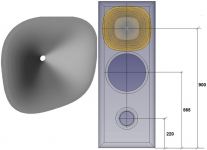 celo_420x1100x44s.png238.2 KB · Views: 360
celo_420x1100x44s.png238.2 KB · Views: 360 -
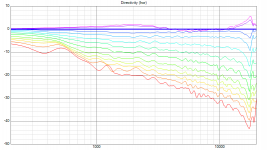 v1_STH_Directivity_(hor)_NORM_20deg.png58.9 KB · Views: 364
v1_STH_Directivity_(hor)_NORM_20deg.png58.9 KB · Views: 364 -
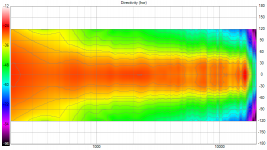 v1_STH_Directivity_(hor)_mapa.png197.7 KB · Views: 353
v1_STH_Directivity_(hor)_mapa.png197.7 KB · Views: 353 -
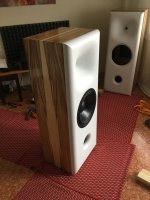 image1(2).jpeg189 KB · Views: 226
image1(2).jpeg189 KB · Views: 226 -
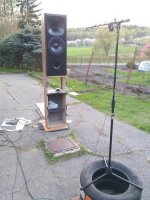 sth12_venku_measss.jpg233.1 KB · Views: 229
sth12_venku_measss.jpg233.1 KB · Views: 229 -
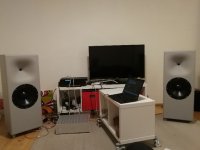 IMG_20181216_232224-768x576.jpg73.1 KB · Views: 213
IMG_20181216_232224-768x576.jpg73.1 KB · Views: 213 -
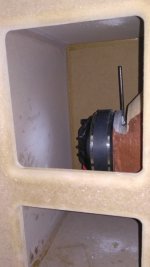 sth12_dayton_driver_mounts.jpg101.5 KB · Views: 204
sth12_dayton_driver_mounts.jpg101.5 KB · Views: 204 -
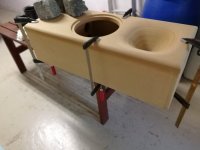 bedna-lepeni-celo.jpg70.1 KB · Views: 214
bedna-lepeni-celo.jpg70.1 KB · Views: 214 -
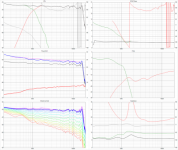 t_v2_sth_ok_six_packs_382.png77 KB · Views: 153
t_v2_sth_ok_six_packs_382.png77 KB · Views: 153
Last edited:
These are meant to be a one man party for the critical listening, where a sweet spot is static.... if I can keep everything on axis by angling, what does the rest of the polar mean to me?
Wait one, you mean to tell me this ode to two ways has always been about a single seat?! If this had been in the first post, it was a one n' done 'no brainer' layout.
MTM with horn axis focused wherever you want it [recommend level with ears] with woofers canted up/down same angle to overlay it and DSP'd proper time/phase delay. Your choice as to where you toe in [or not] each channel, though if you use conical/OS WG [1 WL long to load to the XO point] it shouldn't be critical once the room is properly dealt with.
Polars/whatever don't matter, much ado about nothing, just the speakers/LP in the right spot and getting the room right.
GM
Polars/whatever don't matter, much ado about nothing, just the speakers/LP in the right spot and getting the room right.
GM
Polar response does matter in real/normal rooms. It determines the FR of the sound being reflected from the room. This matters in all small listening rooms.
An os horn is not the geometry of a complete finite acoustic horn that follows this geometry only in the throat and body. As the mouth is approached the profile radius needs to return to a decline in respect to horn axial length; and while doing so, avoids discontinuities in the bounding curve's 2nd. derivative; i.e., at the point of departure for mouth lips, the radii of curvature should match. If this tack is followed, reflectance will be minimized within the horns pass-band, the lower boundary of which, is roughly defined by the relation wavelength/(mouth circumference) = 1.
WHG
Could you give some examples of such horns?
A spherical horn with a full 360° roll back, perhaps?
Or smaller:
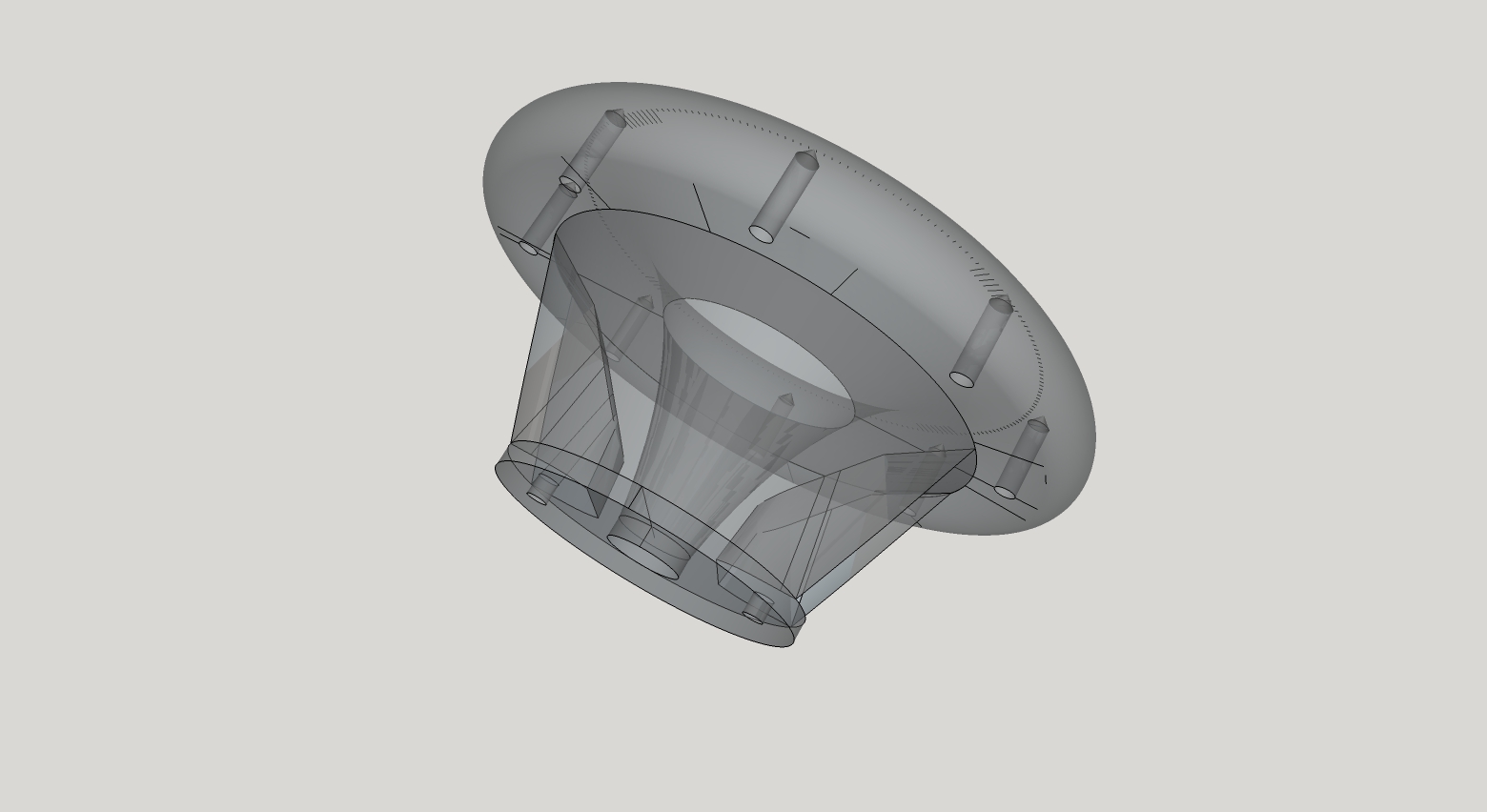
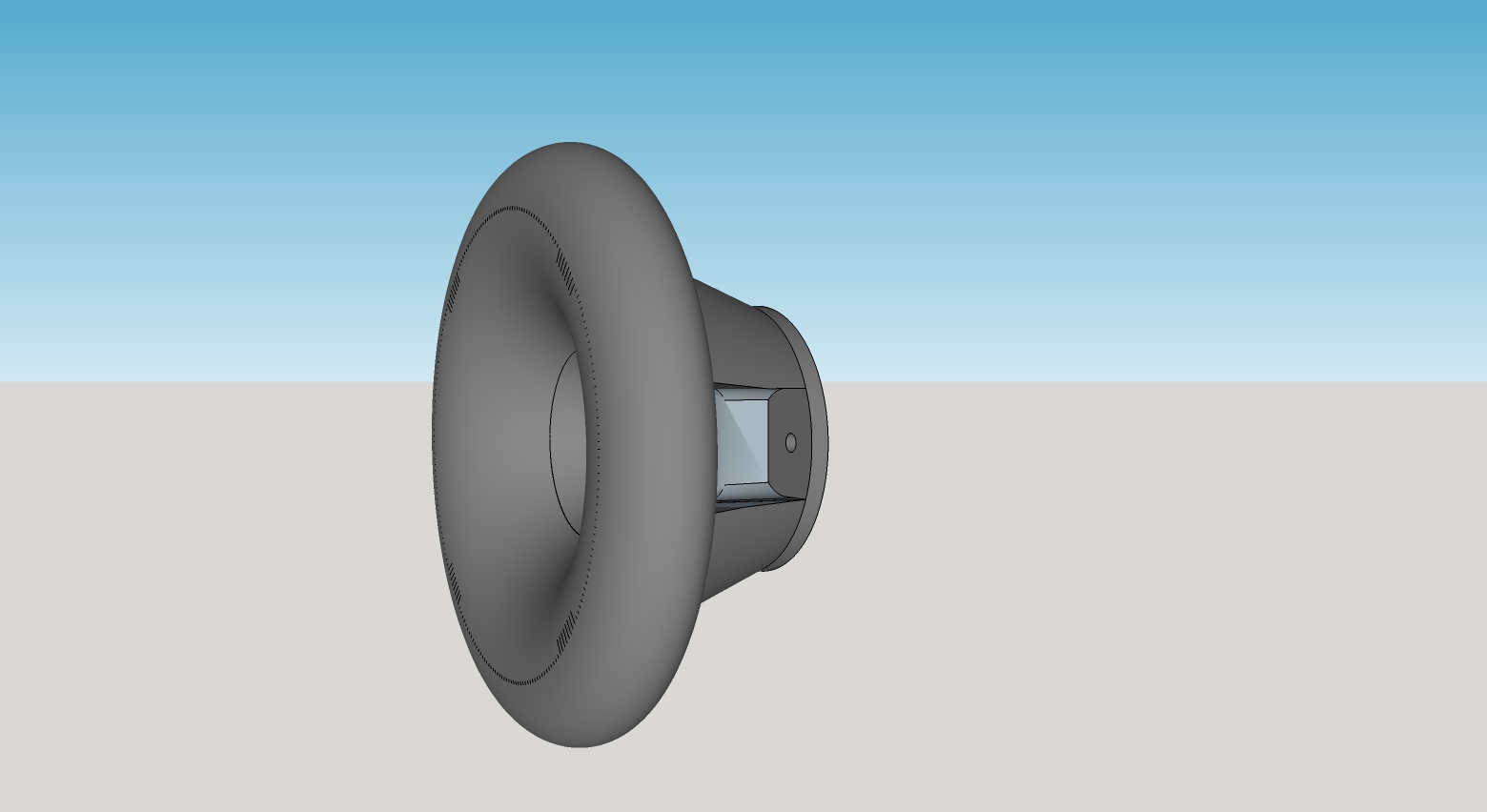
Last edited:
Polar response does matter in real/normal rooms. It determines the FR of the sound being reflected from the room. This matters in all small listening rooms.
Of course, that's why we prefer to use horns/WGs on this thread
Also, even if this wasn't the case, we tend not to hear nulls down low unless broadband, so still much ado about nothing for the vast majority of folks.
GM
It's not the cheapest horn at €300,- euro/piece. Here is some more info: https://en.toutlehautparleur.com/media/catalog/product/datasheet/supravox/PAV_1P.pdf Vertical is also very narrow with 25 deg.
I just ordered a pair of P.Audio PH-3520. We'll see how they do with the Altec's
Last edited:
A diy project built around one of Marcel's (mabat) STH (now ATH4) waveguides.
Drivers: B&C DE250 + SICA 12SR3PL.
Very nice polar/directivity response! At what XO frequency?
Thanks.
I just ordered a pair of P.Audio PH-3520. We'll see how they do with the Altec's
Already canceled.. I'd have to wait for 3 months to get them.. That a bit to much.
Drivers: B&C DE250 + SICA 12SR3PL.
That SICA Woofer seems to work well in two-way configurations despite being specified as subwoofer.
It would be interesting for a 12" MTM with a 1.4" + horn.
Regards
Charles
Yes, that's a very nice project by a guy who is an acquaintance of mine. Crossover is just above 1 kHz as can be seen from the pictures shown. What's even more attractive is the price - for the parts cost it's only about 1300 EUR (~ $1500?) for a pair including the baffles with waveguides milled in. Really nice and still not so big speakers.
Last edited:
Already canceled.. I'd have to wait for 3 months to get them.. That a bit to much.
Was going to ask why you chose the ph-3520 over the ph-3220 but never mind
Greetings to all!
I would like to ask an opinion regarding the woofer of this two-way project. I found the BEYMA 15p80FeN or 15p80Nd and I saw that theoretically they should be valid candidates, someone describes them with a precise and powerful sound ... unfortunately I have no experience on them, I would ask if someone used them to report their experience , in particular15p80feN. Thank you in advance, renewing greetings.
Mleod
I would like to ask an opinion regarding the woofer of this two-way project. I found the BEYMA 15p80FeN or 15p80Nd and I saw that theoretically they should be valid candidates, someone describes them with a precise and powerful sound ... unfortunately I have no experience on them, I would ask if someone used them to report their experience , in particular15p80feN. Thank you in advance, renewing greetings.
Mleod
Attachments
There's no denying the progress of (scientific) research in this field and your contribution to this.
The point of the quote is to illustrate the relevance of the white horns in historical perspective.
I'm not looking for praise of my work, I just don't understand the fascination for obsolete technology that we know can be improved upon.
So what is the ultimate 'modern' designed horn to use for a 'big' 2-way setup (ie. to pair with 1x or 2x 15" bass drivers running upto 500-800hz)?
There may not be an "ultimate", but for any desired situation and given constraints, there is always an optimum. Give me these criteria and I can design a device that is optimum. Now, of course, the more restrictive the criteria, the more compromises must be accepted in the optimum. It almost always comes down to size. People just don;t want to accept the size of device that can be required to go lower in frequency and the tradeoff with size is always a substantial one.There's no such thing as 'ultimate' or 'one size fits all' in audio
It depends on your objectives/preferences, room, cabinet, compression driver etc. and budget vs ability to DIY.
Sure horns can be modeled, but it takes considerable skill (and computer tools) to do so.So as we lower the freq, things get better but...then theres the horn...we can't model for the horns polar can we? I can't even imagine how its polar interacts with the horn at xover...
I've done some angling of devices in studies before and it is surprisingly ineffective.So back to the issue with the dual 15's....One axis to about 15 degrees at 630hz we good. This polar represents 2 drivers and dead center of the drivers equals on axis I believe, so if I could angle the speakers to my ear this could work...
It can mean a lot since you hear all of the sound from all the room reflections. You don't just hear the axial direct sound. The timbre of a signal is highly influenced by the room and its reflections and these depend on the loudspeaker systems polar response.The directivity of the 15" is already increasing due to driver size, near xover, 2 woofers increase directivity by introducing nulls at 37 degrees which open back up as you get wider....I don't know what all these nulls do to the room energy, but lessen would be one....
if I can keep everything on axis by angling, what does the rest of the polar mean to me?
What we want is that the directivity be constant and lobing does not do that since the directivity is ever changing. As you say all direct radiating drivers have ever increasing directivity, even a pair of them does as well. What we want is that the directivity of the woofer and the waveguide match at the crossover such that there is not large change in the overall directivity through the crossover.I now see the allure in MTM, and how the woofers spacing create a tight sweet spot without the need of angling the speakers as long as the T is at ear level. I dare say the polars are better...woofer wise, when they are stacked tighter together but now you must get the center of the pair at ear level , to which I suggested angling. If I remove the redundant coverage, the polars open right up...and now I am increasing the rooms energy once again....no? The high lobing is the high direcitivty is it not? As on axis is unaltered, an increasing amount of nulls off-axis, is the reduction of room energy....please correct me if I'm seeing this wrong. The one thing I see that isn't preferable is the off axis response colorization, its not exactly comparable to what a horn does is it.
jzagaja has also developed this monster OS waveguide that would work from about 600Hz.
It takes a BIG device to go down to 600 Hz. This looks like a good attempt.
An os horn is not the geometry of a complete finite acoustic horn that follows this geometry only in the throat and body. As the mouth is approached the profile radius needs to return to a decline in respect to horn axial length; and while doing so, avoids discontinuities in the bounding curve's 2nd. derivative; i.e., at the point of departure for mouth lips, the radii of curvature should match. If this tack is followed, reflectance will be minimized within the horns pass-band, the lower boundary of which, is roughly defined by the relation wavelength/(mouth circumference) = 1.
References to horns designed using shape optimization techniques may be found at the reference provided and elsewhere. These are relatively recent studies compared to those mentioned here so far.
Google Scholar
The acoustic load presented to a compression driver by a horn only becomes important if there is a concerted effort to extend the response/output of its lower frequency bound necessitated by some venue force majeure.
The dual direct radiator issues can be mitigated by a crossover that progressively engages the second driver to meet increasing VD requirements concomitant with lower frequency reproduction. Here, because wave length is so much larger the driver dimensions, the two drivers behave as a single source. Above this domain only the top driver is engaged in the overlap region shared by the tweeter.
WHG
You have this correct Bill. If only everyone had your level of understanding.
Already canceled.. I'd have to wait for 3 months to get them.. That a bit to much.
In its hay-day it took 6 months to get delivery of an Abbey. Everyone who was patient was rewarded. It takes time to do things right.
- Home
- Loudspeakers
- Multi-Way
- Is it possible to cover the whole spectrum, high SPL, low distortion with a 2-way?
